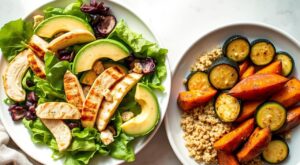Have you ever thought about changing how you eat by skipping meals? It might sound strange, but intermittent fasting is becoming more popular. It’s not about what you eat, but when. This can lead to big changes in your diet.
Studies show it can help you lose weight, boost your metabolism, and improve your health. But how does skipping meals affect your energy and health?
In this article, we’ll explore the science of intermittent fasting. We’ll see how changing your eating habits can lead to big changes. Discover how this lifestyle is changing lives worldwide!
What is Intermittent Fasting?
Intermittent fasting is a unique way of eating. It involves cycles of fasting and eating. This can change how you view food, leading to healthier habits.
Definition of Intermittent Fasting
Intermittent fasting means eating in cycles. It doesn’t tell you what to eat, but when. This way, you get the benefits of fasting and can eat what you like.
Popular Methods of Intermittent Fasting
There are many ways to do intermittent fasting. Here are a few popular ones:
- 16:8 Method: Eat for 8 hours and fast for 16 hours each day.
- 5:2 Diet: Eat normally for five days and limit calories to 500-600 on two days.
- Alternate Day Fasting: Alternate between eating and fasting days for a simple approach.
Benefits of Intermittent Fasting
Experts say intermittent fasting has many benefits. These include:
- Weight loss and fat loss from eating less
- Better insulin sensitivity for blood sugar control
- Less inflammation for better health
- Possible benefits for living longer, as studies suggest
Trying out intermittent fasting can greatly improve your health. It’s worth exploring the different methods.
Understanding the Science Behind Intermittent Fasting
Intermittent fasting is more than just a way to lose weight. It works with your body’s natural processes, affecting metabolism and hormones. Health studies show it can improve overall well-being.
How Intermittent Fasting Affects Metabolism
When you fast, your body starts using stored glucose for energy. As that runs out, it turns to fat. This change makes your metabolism more efficient. Studies show fasting can help your body burn more fat, improving your body shape.
Hormonal Changes During Fasting
Fasting changes your hormones, helping with fat loss and keeping muscle. Insulin levels drop, making it easier to break down fat. Your body also makes more norepinephrine and human growth hormone. These changes help you burn fat better.
Research on Intermittent Fasting and Health
Research on fasting shows many benefits. It can improve brain function, heart health, and lower disease risk. It might even help you live longer. Scientists are studying how it can protect against diseases like diabetes and heart disease.

| Aspect | During Fasting | After Fasting |
|---|---|---|
| Metabolism | Fat burning begins | Increased energy levels |
| Insulin | Decreases significantly | Returns to baseline |
| Growth Hormone | Increases | Moderate levels |
| Cognitive Function | Potential enhancement | Stable mental clarity |
Creating Your Intermittent Fasting Meal Plan
Creating a meal plan for intermittent fasting starts with knowing your nutritional needs and likes. It’s important to make a plan that fits your life and includes healthy foods. A good meal plan can make fasting better and improve your health.
Steps to Design a Personalized Meal Plan
First, pick your fasting schedule, like 16:8 or 5:2. Then, plan your meal times and how many meals you’ll eat. Choose a variety of healthy foods that match your goals. Writing down your favorite fasting foods can help you stay satisfied and energized.
Foods to Include in Your Meal Plan
Choose foods that are full of nutrients. Include whole grains, lean proteins like chicken or tofu, and healthy fats from avocados and nuts. Also, add colorful fruits and vegetables. These foods will keep you full and give you the vitamins and minerals you need.
Foods to Avoid During Intermittent Fasting
When planning your meals, avoid processed foods, sugary snacks, and calorie-rich drinks. These can make you hungrier and lessen the fasting benefits. Drink water or herbal teas to stay hydrated and fight cravings.

| Food Category | Foods to Include | Foods to Avoid |
|---|---|---|
| Proteins | Chicken, fish, legumes | Processed meats, fried foods |
| Carbohydrates | Whole grains, vegetables | White bread, sugary snacks |
| Fats | Nuts, avocados, olive oil | Trans fats, sugary desserts |
| Beverages | Water, herbal tea | Sodas, energy drinks |
Sample Intermittent Fasting Meal Plans
Exploring sample intermittent fasting plans helps you embrace this dietary strategy. Below are practical examples of different methods to guide you on your journey.
16:8 Method Meal Plan Example
The 16:8 meal plan involves an eating window of eight hours within a 24-hour period. Suppose you choose to eat between 12 PM and 8 PM. During this time, you can include a mix of nutritious and satisfying meals. For instance:
- Lunch (12 PM): Grilled chicken salad topped with a variety of vegetables.
- Snack (3 PM): A handful of almonds or a piece of fruit.
- Dinner (7 PM): Quinoa with steamed broccoli and baked salmon.
5:2 Method Meal Plan Example
The 5:2 meal plan offers you five days of regular eating followed by two low-calorie days. Typically, you can consume around 500-600 calories on fasting days. A suggested meal might be:
- Low-Calorie Day Meal: A vegetable soup paired with a small serving of grilled fish.
On the other five days, enjoy your normal diet while incorporating healthy foods to maintain energy levels.
Alternate Day Fasting Meal Plan Example
Alternate day fasting means you alternate between fasting days and regular eating days. On fasting days, you may consume very few calories, while on non-fasting days, focus on a balanced diet. An example could be:
- Fasting Day: Light soups and low-calorie snacks.
- Non-Fasting Day: Whole-grain pasta with a rich tomato sauce and a side salad.
Tips for Success with Intermittent Fasting
Success with intermittent fasting is more than just a schedule. Adding a few practical tips can greatly improve your experience. Focus on staying hydrated, managing hunger, and adjusting your fasting schedule. These tips can help you stick to your plan and enjoy the benefits.
Staying Hydrated During Fasting Periods
Drinking enough water is key during fasting. Water, herbal teas, and zero-calorie drinks keep you full and energized. Hydration helps control hunger and boosts metabolism, making fasting easier. Drink plenty of fluids during your fasting times.
Preparing for Hunger Cravings
Managing hunger during fasting can be tough. Plan ahead to deal with cravings. Try scheduling meals or short fasting periods to reduce hunger. Gradually increasing fasting times helps your body adjust better.
Adjusting Your Fasting Schedule
Everyone’s body reacts differently to fasting. Tailor your fasting schedule to fit your needs. Try different methods like 16:8 or 5:2 to find what works for you. Being flexible with your plan can make fasting more enjoyable. For more fasting tips, check out this guide.

| Strategy | Description |
|---|---|
| Stay Hydrated | Drink plenty of water and zero-calorie beverages during fasting hours. |
| Plan for Hunger | Prepare strategies to deal with hunger, such as meal timing and gradual fasting adjustments. |
| Adjust Fasting Schedule | Experiment with different fasting methods to find what works best for you. |
Intermittent Fasting and Weight Loss
Intermittent fasting is becoming a popular way to lose weight. It naturally reduces calorie intake and boosts fat burning. Studies show it often leads to better results than regular dieting.
How Intermittent Fasting Supports Weight Loss
Intermittent fasting helps control hunger, making it easier to eat less. This can start weight loss when paired with a healthy diet. Hormones like insulin and growth hormone change during fasting, helping burn fat.
Long-term Weight Maintenance Strategies
After losing weight, it’s key to keep it off. Here are some tips:
- Stick to a regular eating schedule.
- Do regular exercise that you enjoy.
- Eat more whole, nutritious foods.
- Keep track of your progress and adjust your diet if needed.
These steps help keep the weight off after using intermittent fasting.
Real-Life Success Stories
Many people share their fasting success stories. These stories show the impact of fasting on weight loss. They talk about losing weight, gaining energy, and improving health.

Intermittent Fasting for Specific Diets
Adding intermittent fasting to your diet can boost health and wellness. If you’re on a Keto, Vegan, or Mediterranean diet, there are fasting plans just for you. Each diet offers flexibility and keeps your nutritional goals in check.
Keto and Intermittent Fasting
Keto intermittent fasting helps burn fat more efficiently. Following a ketogenic diet means eating lots of fat and few carbs. This helps your body use fat for energy when you’re fasting, leading to weight loss and steady energy.
Vegan Intermittent Fasting Meal Options
Vegan fasting can be both tasty and nutritious. Eat legumes, whole grains, fruits, and veggies during your eating times. Try lentil salads or quinoa bowls to get all the nutrients you need while fasting.
Mediterranean Diet and Fasting
The Mediterranean diet focuses on healthy fats, whole grains, and lean proteins. It’s known for its health benefits, making it a favorite for many. By choosing nourishing foods, you can enjoy the benefits of fasting while staying balanced. For more on Mediterranean diet and fasting, see this resource.
Common Myths About Intermittent Fasting
Intermittent fasting often sparks myths that confuse people. Knowing what’s true and what’s not can make a big difference. Many think fasting causes unhealthy eating or is unsafe. But, safe fasting practices can lead to many health benefits.
Debunking Misconceptions
Many myths question the value of intermittent fasting. One common myth is that fasting will make you binge eat later. But, studies show people tend to choose healthier foods when they eat less often. This can help you eat fewer calories and improve your metabolism.
Understanding Safe Practices
It’s key to follow safe fasting practices for the best results. Pay attention to how your body reacts and avoid fasting too much. Drinking water, eating balanced meals, and sticking to a routine can make fasting better.
Clarifying Nutrition During Fasting
When fasting, focus on eating enough nutrients during your eating times. Choose whole foods, lean proteins, healthy fats, and lots of fruits and veggies. This way, you’ll have the energy you need and stay healthy.
Health Considerations for Intermittent Fasting
When you start intermittent fasting, it’s important to know the health aspects. Many people see good results, but some should be careful. Knowing who should avoid fasting and any health conditions is key for a safe experience.
Who Should Avoid Intermittent Fasting
Some groups might face risks with intermittent fasting. Generally, these include:
- Children and adolescents
- Pregnant or breastfeeding women
- Individuals with eating disorders
- People with chronic health conditions, such as diabetes
Medical Conditions and Fasting Protocols
Medical advice is vital for health conditions. Certain health issues need special care:
- Diabetes: Rapid insulin changes can be risky.
- Heart conditions: Long fasting might harm heart health.
- Kidney disease: Fluid and diet limits could cause problems.
Consulting with Healthcare Professionals
Getting medical advice is key for safety. Before starting intermittent fasting, see a doctor, even with health issues. They can create a plan that suits you, ensuring a good experience.
Tools and Apps for Intermittent Fasting
Using the right tools and apps can make fasting easier and more effective. They help you track your fasting times and plan meals. These resources offer support and motivation to stay on track.
Popular Apps for Fasting Tracking
Fasting tracking apps make it easy to monitor your fasting hours. They keep you accountable. Here are some top choices:
- Zero: This app tracks your fasting times and offers insights. It also has reminders and a community for support.
- Life Fasting Tracker: It’s simple to use and tracks your fasts, food, and weight. Connecting with friends boosts motivation.
- Fastic: It combines fasting tracking with meal planning. It offers recipes and a community to help you reach your goals.
Meal Planning Tools and Resources
Meal planning tools are key to success with intermittent fasting. They help you plan balanced meals that fit your fasting schedule. Apps like Mealime or Plan to Eat make organizing meals easy. You can tailor plans to your dietary needs and preferences.
Community Support for Intermittent Fasters
Having a supportive community is invaluable on your fasting journey. Online forums and social media groups are great for sharing experiences and recipes. Joining these groups can help you stay committed to fasting, as you share your journey with others who get it.
Conclusion: Embracing Intermittent Fasting
Starting intermittent fasting is more than just changing your diet. It’s a journey to a healthier you. Think about what you want to achieve, like losing weight or feeling more energetic. Having clear goals helps you stay motivated.
Reflecting on Personal Goals
Creating a good meal plan is key to success with intermittent fasting. Choose healthy foods that make your body happy. It’s okay to enjoy your meals and not feel like you’re missing out.
Remember, your meal plan should fit your life and tastes. Change it as needed to keep it working for you.
Building a Sustainable Meal Plan
Support is important on your fasting journey. Celebrate every small win and join fasting communities for support. Talking to others can give you new ideas and keep you going when it’s tough.












